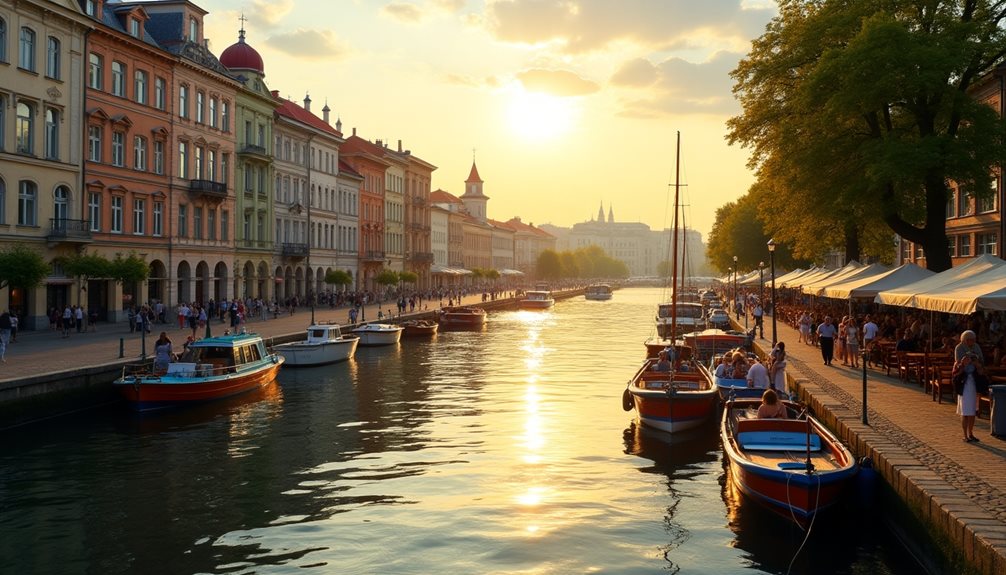When you explore the evolution of Russian film, you’ll notice a fascinating mirror reflecting the nation’s societal shifts. Early Soviet cinema’s avant-garde styles, pioneered by directors like Eisenstein, were not just artistic choices but tools for revolutionary propaganda. As the political climate evolved, so did the narratives, moving from the rigid frameworks of socialist realism to the more liberated expressions during the Thaw. Today, contemporary Russian filmmakers grapple with identity and transformation, influenced by a global stage. But what exactly drives these cinematic shifts, and how do they resonate with the broader societal changes?
Early Soviet Cinema
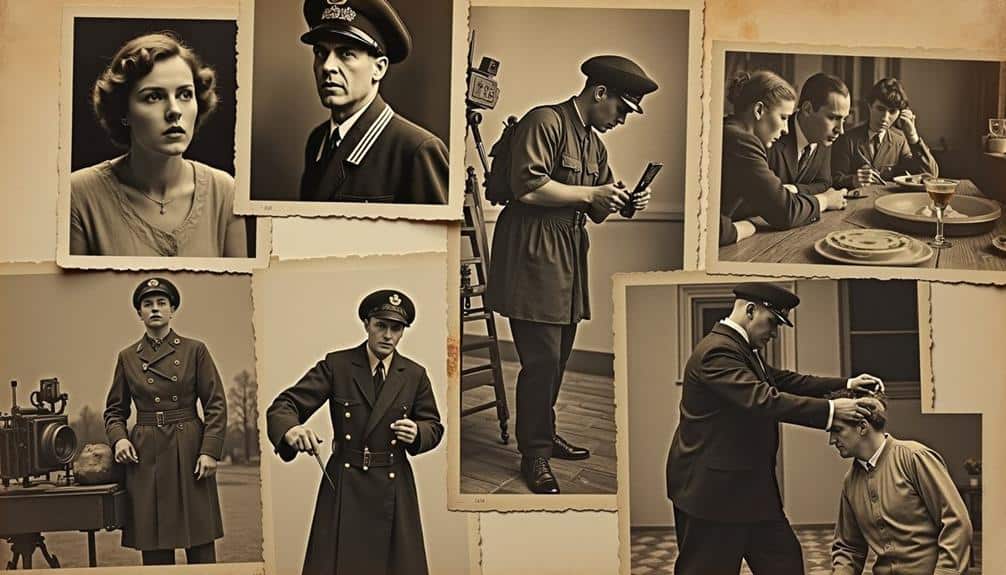
Early Soviet Cinema marked a revolutionary period in film history, characterized by bold experimentation and ideological fervor. You’re stepping into an era where the silent era’s limitations didn’t stifle creativity but rather spurred innovative cinematic techniques. Early directors like Sergei Eisenstein and Dziga Vertov pushed the boundaries of film with their avant garde movement, using montage to convey complex ideas and emotions.
In this historical context, the films weren’t just stories; they were tools to convey cultural symbolism and reflect the societal changes of the time. You’ll find that these directors used stark imagery and dramatic contrasts to symbolize the struggles and aspirations of the Soviet people. Film festivals of the era celebrated these groundbreaking works, and audience reception was often intense, as viewers were both entertained and provoked to think critically about their world.
Understanding early Soviet cinema means recognizing the interplay between art and ideology. The films of this period weren’t merely for entertainment; they were a means of education and reflection, deeply embedded in the cultural and political milieu of the time. This approach to filmmaking set the stage for future innovations and left an indelible mark on global cinema.
Propaganda and Revolution
The intertwining of propaganda and revolution in Russian film wasn’t just a coincidence; it was a deliberate and powerful strategy. Filmmakers utilized revolutionary themes to craft political narratives that aligned with the state’s ideological battles.
Soviet censorship ensured that only films promoting the desired cultural identity reached the public. Directors like Eisenstein employed propaganda techniques to shape national identity and reinforce the historical context of the Russian Revolution.
You can see how film festivals became battlegrounds for artistic resistance, showcasing works that either conformed to or subtly pushed against state-imposed narratives.
Films like “Battleship Potemkin” didn’t just tell a story; they were carefully constructed to influence public perception and rally support for the new Soviet regime. The revolutionary fervor wasn’t just depicted but was ingrained into the fabric of these films, reflecting the ideological shifts happening in society.
Socialist Realism Era
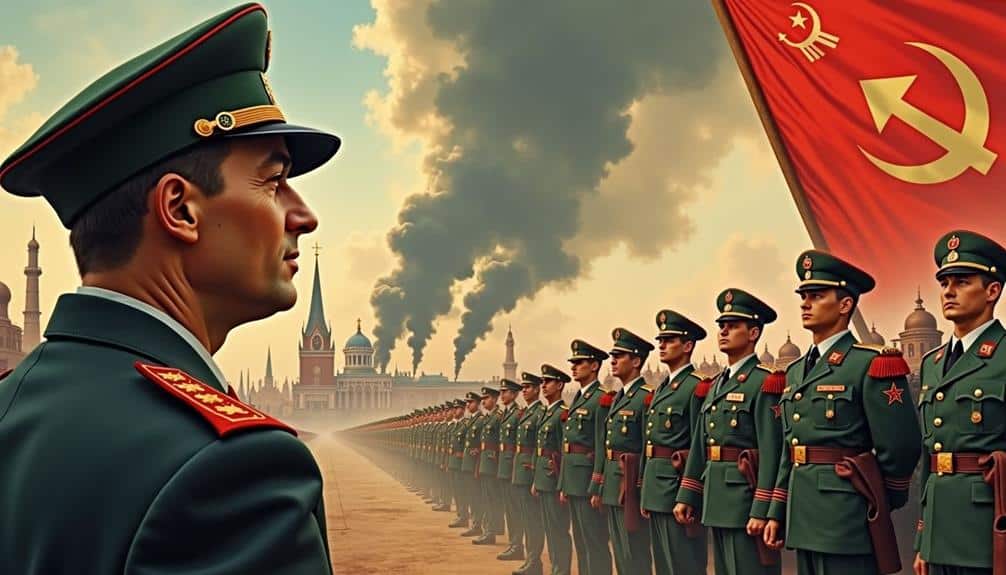
As revolutionary fervor settled into a structured state apparatus, a new artistic directive emerged—Socialist Realism. You’ll find that this era, spanning from the 1930s to the 1950s, wasn’t just a style but a mandated framework for all Soviet arts, including film. The primary goal was to promote socialist ideals through ideological representation, ensuring that every piece of art served the state’s objectives.
Directors had to navigate artistic constraints, as state censorship dictated what stories could be told and how. Films had to depict the Soviet life as a utopia, brimming with optimism, even if reality was far more complex. This created a unique cinematic language, where heroes were often idealized workers or soldiers, embodying the perfect Soviet citizen.
Yet, despite these constraints, some filmmakers managed to infuse their work with emotional resonance, using historical context to connect with audiences deeply. They subtly critiqued or highlighted genuine cultural identity within the rigid boundaries set by the state.
Understanding this period requires recognizing how tightly film was woven into the fabric of Soviet ideology. It wasn’t merely entertainment; it was a tool for shaping societal norms and reinforcing the communist ethos.
Thaw and Khrushchev Reforms
While the firm grip of Socialist Realism began to loosen, the period known as the Thaw and Khrushchev Reforms marked a significant shift in Soviet cinema. During this era, you’ll notice a profound cultural shift as filmmakers began to explore themes previously deemed inappropriate. The political climate under Khrushchev allowed for greater artistic freedom, enabling directors to infuse their work with nuanced social commentary.
Cinematic experimentation flourished as directors pushed the boundaries of storytelling and visual style. Films like Mikhail Kalatozov’s “The Cranes Are Flying” broke away from propagandistic narratives, offering a raw, humanistic portrayal of war’s impact on individuals. This shift wasn’t just about aesthetics; it was a response to the ideological challenges of the time, reflecting a society in flux.
Audience reception during the Thaw was enthusiastic, as people eagerly consumed content that mirrored their own experiences and aspirations. However, this newfound freedom also came with its own set of restrictions and contradictions.
The historical context of the Thaw reveals a complex interplay between state control and creative expression, making it a pivotal moment in Soviet film history. This era’s legacy is one of bold artistic exploration amid shifting political landscapes.
Stagnation and Late Soviet Period

Entering the late Soviet period, filmmakers faced an era often characterized by stagnation, both politically and culturally. Censorship issues became more stringent, curbing the range of acceptable artistic expressions. Directors had to navigate ideological constraints carefully, often resulting in a subdued creative atmosphere. Despite these limitations, some filmmakers found subtle ways to critique the system, using allegory and symbolism.
During this time, cultural stagnation pervaded Soviet society, reflecting in the film industry’s output. The accessibility of films was also controlled, with state agencies determining what the public could see. Audience reception varied; some longed for more meaningful content, while others accepted the status quo, influenced by limited exposure to alternative viewpoints.
Director limitations stifled innovation, yet genre experimentation provided a narrow, though valuable, escape. Science fiction and historical dramas became avenues for indirect commentary on contemporary issues. Filmmakers like Andrei Tarkovsky pushed boundaries, albeit under constant scrutiny.
In this constrained environment, films often mirrored societal discontent subtly. The late Soviet period’s cinematic landscape, though restricted, captured the complexities of a society grappling with ideological rigidity and a yearning for change, setting the stage for future transformations.
Perestroika and Glasnost Influence
The sweeping reforms of Perestroika and Glasnost in the mid-1980s dramatically reshaped the Russian film industry, breaking the chains of censorship and ideological constraint.
You see, Perestroika’s influence wasn’t just economic; it also sparked a cultural revival. Glasnost’s impact on film was profound, allowing filmmakers to explore previously forbidden themes and offering a platform for societal critique.
During this period, the historical context of the Soviet Union’s political and social upheaval played a crucial role. Directors gained artistic freedom, no longer shackled by stringent film censorship. They began to tackle controversial subjects such as corruption, war, and the collapse of Soviet ideals.
This newfound liberation led to significant cultural shifts, as audiences were exposed to more authentic and diverse narratives. Film reception during this era revealed a society hungry for truth and introspection.
Movies like “Repentance” and “Little Vera” resonated deeply, reflecting the public’s desire for transparency and change. The perestroika influence and glasnost impact not only redefined Russian cinema but also mirrored the collective yearning for a more open and honest discourse.
This transformative era set the stage for the subsequent post-Soviet film renaissance.
Post-Soviet Film Renaissance
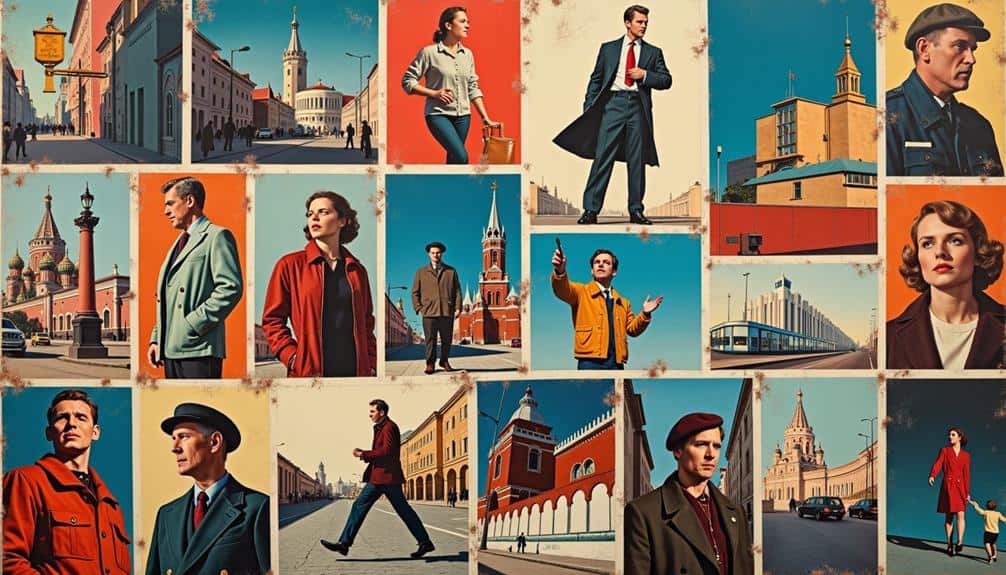
Emerging from the turbulent aftermath of the Soviet Union’s collapse, the Post-Soviet Film Renaissance marked a period of profound artistic exploration and reinvention in Russian cinema. Independent cinema flourished as filmmakers broke free from state control, enabling a diverse range of voices to express new perspectives on society.
This shift was epitomized by the rise of film festivals, which provided platforms for showcasing groundbreaking works and fostering dialogue among creators and audiences.
During this era, there was a notable documentary resurgence, reflecting the nation’s quest for self-understanding and truth. Filmmakers used digital storytelling techniques to craft intimate narratives that resonated deeply with viewers. Audience engagement became crucial, as films began to address the evolving cultural identity of a rapidly changing Russia.
Genre exploration also became a hallmark of this renaissance, with directors experimenting boldly across horror, science fiction, and drama.
This period witnessed significant cinematic innovation, as creators pushed the boundaries of traditional storytelling and visual aesthetics. By navigating these new creative freedoms, Russian cinema not only mirrored societal changes but also contributed to shaping the national psyche, highlighting the enduring power of film as a cultural force.
Contemporary Russian Filmmakers
While navigating the complexities of the 21st century, contemporary Russian filmmakers have embraced an eclectic mix of tradition and modernity, carving out a distinct space in global cinema.
You’ll notice how they use artistic expression to explore cultural identity and societal issues. Directors like Andrey Zvyagintsev and Kirill Serebrennikov push narrative innovation, blending digital filmmaking with conventional storytelling.
Genre experimentation has become a hallmark, with films ranging from psychological dramas to science fiction. This broadens the scope of Russian cinema, offering new perspectives and challenging established norms.
International collaborations, often seen in co-productions, have allowed Russian filmmakers to reach wider audiences and incorporate diverse influences.
Female directors, such as Anna Melikyan, bring unique viewpoints, enriching the cinematic landscape. Youth perspectives are increasingly prominent, with younger directors addressing contemporary issues that resonate with their generation.
Historical adaptations remain significant, reflecting on Russia’s past to provide context for its present and future.
Avant garde influences are also evident, pushing the boundaries of form and content. These filmmakers create works that are both visually and intellectually stimulating, contributing to the dynamic evolution of Russian cinema.
Global Impact and Recognition
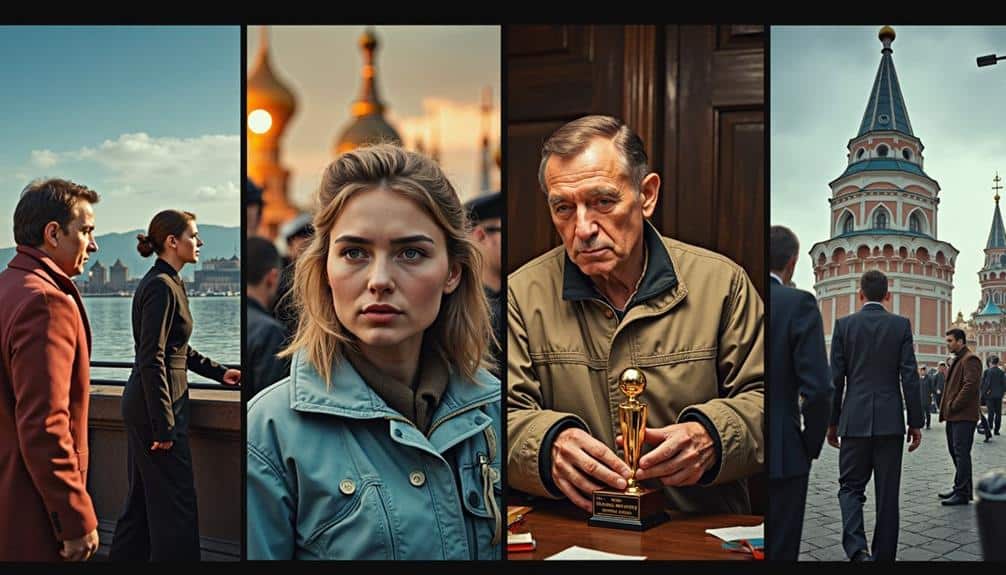
Breaking into the global stage, Russian cinema has garnered significant attention and acclaim, reflecting its profound impact and recognition worldwide. You can see this through its active participation in film festivals, where movies like “Leviathan” and “Loveless” have received critical acclaim. These films foster cultural exchange and offer cross-cultural storytelling that resonates with global audiences.
International collaborations have played a pivotal role, allowing Russian filmmakers to blend their artistic influences with those from other cultures. This genre diversification not only enriches the narrative but also broadens the appeal of Russian cinema.
Cinematic innovations, such as the use of digital distribution platforms, have further enabled Russian films to reach a wider audience, breaking geographical barriers.
The global impact of Russian cinema is also evident in the way it has integrated into artistic communities worldwide. By participating in co-productions and international projects, Russian filmmakers contribute to a rich tapestry of global storytelling.
This collaboration leads to mutual enrichment, where cinematic techniques and storytelling methods are shared and refined. The recognition and critical acclaim garnered on the international stage underline the significant contributions of Russian cinema to the global film industry.




